

English Tenses Timeline - For ESL EFL TESOL TEFL TOEFL Students Teacher and Classes for Quick Reference. This timeline tenses chart provides a handy reference sheet to English tenses and their relationship to one another and the past, present and future.
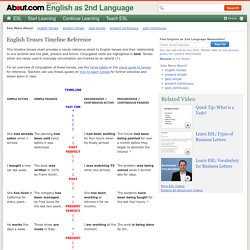
Conjugated verbs are highlighted in bold. Tenses which are rarely used in everyday conversation are marked by an asterik (*). For an overview of conjugation of these tenses, use the tense tables or the visual guide to tenses for reference. Teachers can use theses guides on how to teach tenses for further activities and lesson plans in class Other Helpful Tense Reference Links Upper Level Grammar Resources Lower Level Grammar Resources Grammar Quizzes. Verb Tenses. Summary: This handout explains and describes the sequence of verb tenses in English.
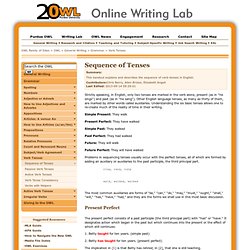
Contributors:Chris Berry, Allen Brizee, Elizabeth AngeliLast Edited: 2013-09-14 09:29:01 Strictly speaking, in English, only two tenses are marked in the verb alone, present (as in "he sings") and past (as in "he sang"). Other English language tenses, as many as thirty of them, are marked by other words called auxiliaries. Understanding the six basic tenses allows one to re-create much of the reality of time in their writing. Verb Tenses Worksheets. "What a comprehensive site!
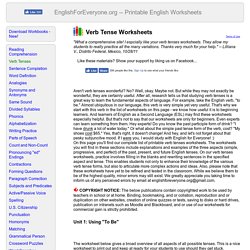
I espcially like your verb tenses worksheets. They allow my students to really practice all the many variations. Thanks very much for your help. " -- Lilliana V., Distrito Federal, Mexico, 10/28/11 Like these materials? Show your support by liking us on Facebook... Aren't verb tenses wonderful? COPYRIGHT NOTICE: The below publications contain copyrighted work to be used by teachers in school or at home.
Unit 1: Using "To Be" The worksheet below gives a broad overview of all aspects of all possible tenses. ESL Grammar Worksheets. Nouns ESL Grammar Worksheets: List of 100 Common Nouns ESL Grammar Worksheets: Nouns (1) - an introduction to Nouns (people, places, and things) ESL Grammar Worksheets: Nouns (2) - an introduction to Nouns (people, places, and things)
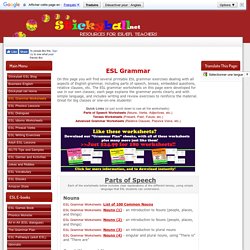
English Verb Tenses - EnglishTenses.com. Past-English. Verb Tenses. Verb Tenses. In English, there are three basic tenses: present, past, and future.

Each has a perfect form, indicating completed action; each has a progressive form, indicating ongoing action; and each has a perfect progressive form, indicating ongoing action that will be completed at some definite time. Here is a list of examples of these tenses and their definitions: Simple Forms Present Tense Present tense expresses an unchanging, repeated, or reoccurring action or situation that exists only now. Past Tense Past tense expresses an action or situation that was started and finished in the past. Future Tense Future tense expresses an action or situation that will occur in the future. The speaker of the House will finish her term in May of 1998. The future tense can also be expressed by using am, is, or are with going to. The surgeon is going to perform the first bypass in Minnesota. We can also use the present tense form with an adverb or adverbial phrase to show future time.
The president speaks tomorrow. Verb Tenses. Summary: This handout explains and describes the sequence of verb tenses in English.
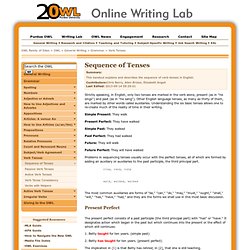
Contributors:Chris Berry, Allen Brizee, Elizabeth AngeliLast Edited: 2013-09-14 09:29:01 Strictly speaking, in English, only two tenses are marked in the verb alone, present (as in "he sings") and past (as in "he sang"). Other English language tenses, as many as thirty of them, are marked by other words called auxiliaries. Understanding the six basic tenses allows one to re-create much of the reality of time in their writing. Tenses. It's all about time.
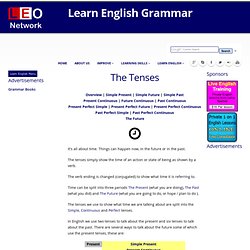
Things can happen now, in the future or in the past. The tenses simply show the time of an action or state of being as shown by a verb. The verb ending is changed (conjugated) to show what time it is referring to. Time can be split into three periods The Present (what you are doing), The Past (what you did) and The Future (what you are going to do, or hope / plan to do ). The tenses we use to show what time we are talking about are split into the Simple, Continuous and Perfect tenses.
In English we use two tenses to talk about the present and six tenses to talk about the past. Tenses.